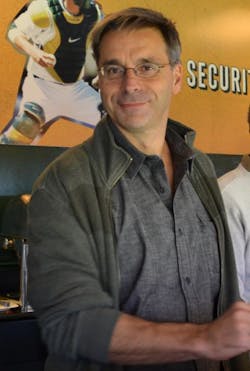Interview: Andrea Betti-Berutto, CTO, GigOptix
NF: Can you tell us a little about GigOptix, its roots, and how and why it became a company?
AB: GigOptix was founded in 2007 with the acquisition of the assets of iTerra Communication, of which I was one of the founders. Since 2001, iTerra had developed high-speed technology in GaAs and InP devices, and packaged multichip solutions for broadband RF and fiber-optic applications (addressing markets such as high-performance telecommunications, instrumentation, and military systems). In 2007, I met Avi Katz, who is now GigOptix’s CEO. Together, we started a thorough review of iTerra technology, of the overall market situation, and of potential directions for growth. It became clear that the fiber-optic market was emerging from a slow period of the previous five years and that 40- and 100-Gb/s applications would offer opportunities. We saw that there was no semiconductor vendor truly serving fiber-optic markets as a “one-stop shop,” from short links (such as data-center interconnections) to long hauls (such as submarine links).
We executed this plan in the past five years with the following acquisitions: Helix (Switzerland), with products and expertise in mixed-signal SiGe BiCMOS for short-reach optical links, such as in data-communications centers; Lumera (Bothell, WA), with high-speed, compact, low-power polymer-based optical modulator technology for data communications and telecommunications applications, which we now offer to customers bundled with our ChipX integrated-circuit (IC) drivers, and which allowed us to move in complex CMOS integration for future fiber-optic-interconnect opportunities; and Endwave, with millimeter-wave technology for point-to-point applications, which we consider quite complementary to our fiber-optic product lines. GigOptix management, under Avi Katz, has integrated these companies and technologies in an efficient and synergistic way, with a high level of focus to maintain our planned strategy for organic growth.
NF: By designing the ICs that link the optical and electronic domains, GigOptix occupies an interesting area—at the intersection between millimeter-wave and fiber-optic technologies. How do you branch both areas?
It is an interesting area, and requires a great deal of expertise to understand how to bring the different technologies together and to benefit from each other. We have created a strong internal technical environment of engineers with solid IC and packaging experience spanning broadband amplifiers at low frequencies through 100 GHz, mixed-signal architectures, and various optical interfaces and devices. We encourage internal technical exchanges and cross-training between teams. This is why we see the E-band product line as not only complementary to our fiber-optics business but also very synergistic from a technical point of view. In fact, the E-band IC designers are part of the same engineering team involved in the fiber-optic product lines. We were also able to consolidate most of the product lines under the same roof in our San Jose, CA headquarters facility. This encourages interaction and has created a strong working relationship with our European office in Zurich, Switzerland.
NF: With all the exciting R&D in millimeter-wave technologies, what are the hottest applications driving it right now?
AB: LTE will soon be ubiquitous due to the fact that the adoption rate of new technologies is getting faster and faster. LTE can support rates to 25 Mb/s to the user, so multiply that by the number of people who’ll buy the next-generation Android and iPhone smartphones and you come up with a lot of data being transferred! GigOptix’s mission is to enable high-speed data communications, whether it is optically, wirelessly, or over copper. We expect high-speed wireless infrastructure to be rolled out to address the forecasted user demand for more bandwidth and we expect E-band technology to play a central role in enabling this revolution.
NF: What technology advancements are needed to enable the next generation of millimeter-wave applications?
AB: When point-to-point radio designers must deal with chip-and-wire assembly at 80 GHz, minimizing the number of ICs per transceiver is critical; therefore, a high level of integration must be achieved. This means that advanced design techniques are needed to integrate full transceivers with both analog and digital control. These may be single ICs using low-cost technologies such as SiGe BiCMOS. Output power must be delivered in the most efficient ways possible, and this can only be achieved with GaAs technologies. One of the challenges in designing highly efficient power amplifiers at such high frequencies is the lack of test equipment to characterize the nonlinear performance of transistors at E-band frequencies, such as millimeter-wave active load-pull systems. This void forces engineers to endure multiple design iterations and foundry runs, and loss of time. Another important need is low-cost packaging with a low-loss E-band interface.
NF: Optical networking has remained a good niche, despite the fact that wireless has nabbed most of the spotlight. Do you expect optical technology to gain any new or bigger opportunities? Or will it just chug along in a support-of-wireless-type role?
AB: This is obviously a question coming from a wireless-focused magazine! Optical networking is becoming much more common than people realize, and displacing both copper and wireless links over a broad range of applications. Optical networking is found increasingly in enterprise networks carrying 10-Gb/s, 40-Gb/s, and even 100-Gb/s data in data centers, disk farms, etc. We see optical FTTX displacing digital-subscriber-line (DSL) and cable modems especially in green field situations such as China. We see optical links being used in the backplanes of routers and large servers to carry data due to the increasing bandwidth needs. Soon we may even have optical PCI!
AB: We’re also seeing optical technology beginning to penetrate consumer applications—for instance, the growth of television screen sizes and resolutions means that there’s now as much as 20 Gb/s of raw image data being transferred onto the screen today. With three-dimensional (3D) TV, 100-Hz+ refresh rates, increasing screen sizes and color depth, 100 Gb/s data transfers are not too far off, and an optical link provides a low-cost, low-power, EMI-free means of transferring the data. GigOptix has the broadest range of optical solutions to address all these applications, so we see great potential for growth in the market.
NF: Although GigOptix is a small company, its technology allows the firm to serve many markets, ranging from defense and medical to telecommunications and consumer electronics. How is the company organized to allow it to be flexible and adaptable in terms of where it puts its focus and resources?
AB: GigOptix is a fast-growing company—generally growing by 26% year on year—so we are successfully juggling our priorities and resources. We are successful because we focus on enabling high-speed data communication for our customers. We have a very flat management structure with three product lines focused on optics, RF/microwave, and application-specific IC (ASIC) products. There is a lot of synergy between the lines, especially between optics and RF/microwave.
The two media appear to be converging, with optics now utilizing coherent receivers, multilevel signaling, and high-power DSPs similar to the RF world in order to cram more bits through a channel. Wireless communications is moving higher in frequency and closer to the optical realm to enable larger bandwidths for transferring more data. Given the similarities, we are able to exploit similar technologies such as GaAs, InP, and SiGe BiCMOS, and design techniques to enable our product solutions.
NF: As a fabless semiconductor company serving such different markets, how varied are the process technologies that you use in manufacturing your integrated circuits (ICs)? What is the most exotic process technology that GigOptix has used?
AB: This depends on your point of view. Originally I was a microwave GaAs power designer and I always felt offended when somebody called GaAs exotic. When I started to use SiGe BiCMOS I understood why GaAs could be considered exotic. Because GigOptix is a fabless semiconductor company, we will use any IC technology that makes sense, from GaAs and InP pHEMTs and HBTs (which might be considered exotics) to SiGe and CMOS. But the most exotic technology we deal with is our proprietary Thin Film Polymer on Silicon (TFPS) process, which allows us to realize highly integrated, ultrabroadband optical modulator configurations —such as DQPSK, RZ-DQPSK, and DP-QPSK—on a single chip and with very low power consumption.
NF: How much of a challenge is it to precisely communicate your design goals to the different outside foundries that you use?
AB: We have been working with same foundry partners for several years, so we cannot say we have challenges from a communications point of view. That said, some IC technologies require more quality control than others, and this is where the experience of our in-house technical team and a good relationship with the foundry is important. Successful collaboration with some of our foundry partners has led to process improvements and to better quality in our products.
NF: How are ICs evolving to better meet the needs of current and future applications?
AB: Customers want more functionality per chip, with lower power consumption and high levels of reliability. To meet these requirements, smart ICs architectures, protection circuits, and correct choice of technology are essential. However, often one technology alone cannot provide all the required performance.
NF: Has there been any feedback from our readers on the iT4036 (delay) that was featured in the April issue of our Defense Electronics supplement?
Yes, your article generated quite a lot of interest in our iT4036, thank you! The device was originally designed for a demanding 10 Gb/s submarine optical telecom application where it is used to align the data and clock to create an optical RZ-DPSK signal. The device is now finding an application in signal integrity testing where it is used to inject jitter into digital communication channels.
NF: As was noted in that article, you are dealing largely with jitter and time-domain related issues in many of your products. Are there any problems in translating the performance levels that you achieve with your products into meaningful parameters for an industry (RF/microwave/wireless) that is largely accustomed to seeing things in the frequency domain?
AB: We have engineering expertise in both microwave/millimeter-wave and fiber-optic technologies, so it is not difficult to manage different requirements depending on the needs of a customer. We understand well the correlation between frequency-domain and time-domain performance levels and often use details from both areas to improve our products. When we deal with ICs for fiber optics, we are in the time domain, which is what our customers understand. When we are working with ICs for E-band point-to-point radios, we work in the frequency domain where those customers are comfortable.
About the Author

Nancy Friedrich
RF Product Marketing Manager for Aerospace Defense, Keysight Technologies
Nancy Friedrich is RF Product Marketing Manager for Aerospace Defense at Keysight Technologies. Nancy Friedrich started a career in engineering media about two decades ago with a stint editing copy and writing news for Electronic Design. A few years later, she began writing full time as technology editor at Wireless Systems Design. In 2005, Nancy was named editor-in-chief of Microwaves & RF, a position she held (along with other positions as group content head) until 2018. Nancy then moved to a position at UBM, where she was editor-in-chief of Design News and content director for tradeshows including DesignCon, ESC, and the Smart Manufacturing shows.

